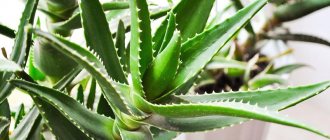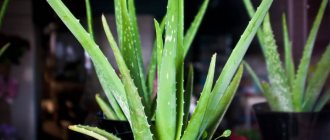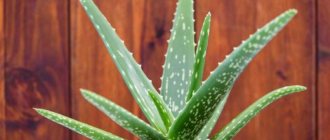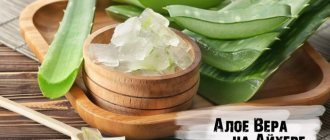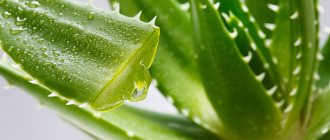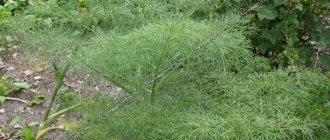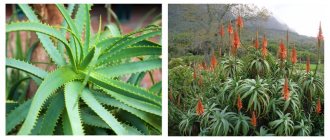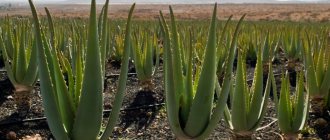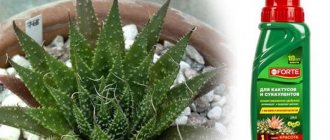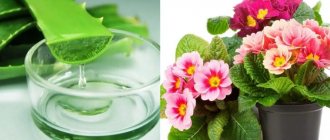Almost the same plant, but outwardly different, are agave (aloe vera) and agave (aloe vera).
Aloe belongs to the group of evergreen crops that are not connected by a single origin. There are about 300 such varieties. The reason for the special classification was the characteristics of each individual subspecies. The most common and easily recognizable among all others are aloe vera and agave.
The latter has a thick trunk with succulent leaves. Agave grows as a bush with wide, lush leaves growing straight up from the center. Moreover, their chemical composition is absolutely the same, as are their rare medicinal properties.
But the external signs vary greatly: aloe vera has a short stem, unlike agave, and thick leaves with a characteristic triangular outline. Agave is different - it resembles a small tree, with fleshy leaves with pointed ends coming straight from the trunk.
Agave leaves are more than thirty centimeters long. No other variety has such a trunk, where leaves grow from the very base. They extend to a maximum height of 50 cm.
Agave, true to its impressive name, has a grayish, dull, unsightly color, which differs from aloe vera, which has a cheerful, juicy bright green color scheme.
What is the difference between these two types?
Only here, however, there is still some difference. Agave is used only for external use, and agave, on the contrary, for internal use. In 1500 BC. A record of aloe was first discovered on ancient papyrus in Egypt. She was found by the German doctor Georg Ebers, a “part-time” writer.
At first, the plant took root in the lands of the South African climate, where dry air and very high temperatures reign. In the wild, both species are found in semi-deserts and deserts, and in the tropical zone.
Then aloe became popular and moved into almost all residential buildings due to its universal ability to treat many diseases at home. Soon it deservedly received the name of a healing “magic wand” - always at hand. Everyone is already accustomed to a certain type of plant on the windowsills of apartments in moderate sizes. In fact, being in a natural habitat, aloe can grow up to 2 or even 3 meters, moreover, it also manages to bloom.
Can these plants be considered one and the same or not?
These crops belong to one species called “aloe”. There are many varieties of aloe and most of them grow in the wild. Two varieties are in demand in home cultivation:
- Aloe vera.
- Aloe arborescens.
The tree-like subtype is familiar to us under the name “agave”. And aloe vera is known as “agave”.
These two cultures are what cause widespread confusion. They have a lot in common, but there are also differences that you should be aware of.
Useful and healing properties of Aloe
- The chemical composition is amazing in the amount of useful microelements that help improve external and internal organs.
- A whole complex of vitamins is hidden in the plant: B12, B6, B2, B9, B1; A, E, C. Minerals: calcium, selenium, copper, sodium, chromium, potassium.
- Aloe with its beneficial properties destroys intestinal, dysentery bacilli and streptococci.
- Contains enzymes, poly- and monosaccharides, amino acids, antioxidants, salicylic acid.
You may also be interested in: What is the difference between black ice and black ice?
Table
AloeAgaveAppearance. Aloe looks like a bush with a circular arrangement of leaves. Appearance. Agave is rather a dwarf tree. The leaves grow from a stem that is more like a trunk. Application. Internal organs. Heart, digestive and urinary systems. Regulating sugar, helping with arthritic pain. Application. External lesions. Ulcers, ulcers, wounds, cuts, varicose veins, etc. Contraindications. Pregnancy, hypotension, poor functioning of the vascular system, diabetes (hypoglycemia) Contraindications. Oncology – promotes the growth of cancer cellsThe table clearly shows the difference between aloe and agave. There are no particularly significant differences observed. Yes, that’s understandable. After all, these are plants of the same species, and by definition they cannot be very different from each other. However, even such little things in medicine are important, and you should know them, because not only your health, but also, possibly, your life often depends on it.
Properties of pulp and juice
Valuable juice and pulp are obtained from aloe. To do this, you need to pick only the lower succulent leaves, the thickest ones, with a dried tip, in which all the necessary substances have already accumulated. But that's not all. Immediate use is not recommended.
To enhance the therapeutic effect, you should first put the cut leaf in the refrigerator for a week. Only then, after taking it out, rinse with boiled, slightly warm water. Next, carefully cut off the thin green skin to reveal the plant pulp necessary for use.
How do they differ in appearance?
But visually, plants have differences that are visible visually. Aloe vera has large, fleshy leaves without thorns. But agave is valued higher for its decorative qualities. A lush shrub of soft blue with bright orange flowers is a favorite plant of interior designers. A detailed comparison is shown in the table:
| Characteristic | Aloe vera | Agave |
| Leaves | no spines, greenish-blue tint, wider appearance, tapering towards the end of the plate | small thorns, with their help life-giving moisture is accumulated, valued in healing, length about 15-17 cm |
| Roots | powerful and developed, going deep into the soil | |
| length | up to 50 cm | up to 90 cm |
| Side shoots | spreading, few lateral branches | there are plenty of them |
| Trunk | lush bush form | thick trunk with succulent shoots |
Application and use of agave
Where and how should this “home doctor” be used correctly:
- When healing cuts and wounds.
- For bites of various insects.
- Perfectly draws out pus, including from boils.
- Get rid of unwanted dandruff, generally help restore hair follicles for hair growth.
- Promotes the healing of ulcers, also with eczema and psoriasis.
- Phlebeurysm.
- Smoothes wrinkles and improves complexion.
- Allatoin helps retain moisture in the skin.
Contraindications
Both agave and aloe vera cannot always be used for medical and cosmetic purposes - these plants also have their own contraindications. Let's find out in what cases the use of succulents is prohibited.
Agave
It is not used when a person has cancer. The fact is that the active bioenzymes included in the composition of agave juice promote the growth and development of not only “good” cells, but also cancerous ones.
The succulent should not be used when treating purulent wounds. Agave juice, although it has wound-healing and bactericidal properties, is not capable of drawing out pus. Thus, the wound may heal, but the pus will remain under the skin, and the inflammatory process will not go away.
Aloe vera
This plant has a wider range of contraindications. Aloe vera juice and pulp should not be used for:
- severe diabetes;
- serious disruptions in the functioning of blood vessels;
- hypotension (low blood pressure);
- pregnancy.
People who have a tendency to spasm blood vessels should approach the treatment of aloe vera with caution. The fact is that its juice has vasodilating properties. Pregnant women are prohibited from ingesting juice for the same reason - due to dilated blood vessels, there is a risk of bleeding.
Uses of aloe vera plant
In terms of chemical composition, agave is in no way inferior to agave, but doctors say that the result will be better if the juice or pulp is used internally. The plant works wonders for the following problems:
- When restoring gums.
- Strengthens the entire cardiovascular system.
- Regulates blood sugar levels.
- Strengthens the overall immune system.
- The functioning of the urinary canals improves.
- Dulls pain and inflammation in arthritis. Eliminates digestive disorders and heartburn.
Growing and care
Agave and agave are grown under the same conditions. Both plants are not whimsical and require only the presence of sun. These succulents are undemanding when it comes to watering. In winter, it is enough to moisten the soil 1-2 times monthly, in summer – 2-3 times weekly. It is important not to flood the soil, otherwise the roots will rot. Watering with warm water is done at the root - there is no need to wet the aloe leaves. Find out all the subtleties and nuances of caring for such a wonderful plant as agave.
You may be interested in reading about the propagation features of agave and the secrets that will help this wonderful and useful plant bloom at home.
Conclusion
So, both types of medicinal plants under consideration are very similar to each other. The only differences are:
- External factors.
- Areas of application.
- Contraindications.
It is simply necessary to grow these affordable healers in your home, since they are quite unpretentious in care, and will come to the rescue in any situation that arises. Well, which of the two plants to choose as a permanent home healer depends solely on personal needs and health problems.
Watch the video in which the author from the “Love for Life” channel will tell you more about the distinctive features of plants.
History and geography
The plants are native to several southern countries:
- Mozambique.
- SOUTH AFRICA.
- Malawi.
- Zimbabwe.
But the culture, imported from the tropics, has taken root well in a colder climate. Aloe is successfully grown as a houseplant almost all over the world. And on an industrial scale, Africa takes the lead with the usual conditions for growing crops in open areas.
There is no geographical difference between agave and agave. Both of these species grow in the same conditions, in hot tropical countries.
Watering, humidity
Even in summer, aloe does not need much water. Watering should be moderate . The optimal frequency is once a week. In winter, on the contrary, rare watering will be enough.
In general, the plant is very sensitive to waterlogging. If water stagnates in the pot, the roots may fester and the aloe will die.
Important! Aloe is drought-tolerant (in winter it can be safely placed next to the radiator). Moderate watering is one of the main criteria for proper care.
How to determine if a plant has enough water? When watering, pay attention to the presence of moisture on the tray. If the moisture has settled, it means there is enough water. Pour it out and stop watering.
General concept
Agave is a tree-like type of aloe, the height of which can reach 4 m in the wild and 1 m in an apartment. Aloe vera is a succulent herbaceous plant. The word "succulent" means succulent - something that holds water molecules. The juice is the main part used in cosmetology and medicine.
Agave. The illustration for the article is used from the site pocvetam.ru
Methods for propagating Agave at home
Aloe arborescens, like other Aloe species, can be propagated from seeds or cuttings.
But male and female flowers of the same plant cannot interbreed with each other or with plants of the same variety. To obtain fertile seeds, plants of different varieties of Aloe are needed. And germinating the seeds themselves is a rather lengthy and complex process.
Propagation of Aloe arborescens by stem cuttings
The only easy method of propagating this flower is through stem cuttings and side shoots (babies). A cutting is nothing more than a “branch” that needs to be separated from the mother plant with a sharp knife. This procedure must be performed at the beginning of the growing season - in the spring.
Next, you need to clean the cuttings from dried leaves and disinfect them. Leave them in a shaded and ventilated area for a week to facilitate the release of sap, which can prevent rooting. After this, you can plant the cuttings in soil made of coarse sand and fertile soil (the optimal ratio is 3:1). This plant takes root easily after planting in the ground. During rooting, moisten the soil as little as possible. Rooting time is from 3 weeks to several months, depending on weather conditions. Once the young flower has taken root, it can be replanted and grown like other mature plants.
How to propagate domestic Agave by children
Aloe arborescens is propagated in the same way by children. Side shoots can be easily separated during transplantation. Make sure you separate the baby from the roots. If you separated the rosette with a knife, let it dry for several days until a growth appears on the cut area. Plant the young shoot in a container with well-drained soil, without burying the leaves. Since the root system will likely be small or non-existent, you will need to secure the shoot with a layer of pebbles or something else. Within a few weeks, the root system should be strong enough to support the growth of the new plant.
Origin
The homeland of the plant is Africa. Wild species are also found in Morocco, Madagascar, and the Arabian Peninsula. Grows in Asia and India. Some rare species grow on the island of Socotra. The famous sabur is also produced here - a dry extract that is made by drying the liquid from the plant.
In nature, aloe is resistant to harsh hot climates. High temperatures do not prevent some specimens from growing up to 6 meters in height. The leaves of such a giant store a huge amount of valuable raw materials.
The most cultivated species is aloe vera, which is deservedly considered a “home healer”. Such a plant rarely reaches large sizes; it is mainly small bushes of 50-80 cm.
Medical aspect.
Let's take a quick look at the main feature of aloe - its healing properties. Let us first describe the common features characteristic of both aloe and agave:
- The plant is a real plant for the production and storage of vitamins. Here you can find almost everything: B1; AT 2; AT 12; AT 9; AT 6; WITH; E; A.
- There were also mineral elements: copper, selenium, sodium, chromium, calcium...
- Amino acids, antioxidants, mono- and polysaccharides and enzymes - everything is presented in full and in considerable quantities.
A solid list that only confirms the fact that aloe is truly a valuable plant, and not a “puffed up hero”. Well, now it’s time to talk in more detail about the difference between aloe and agave.
Properties of agave
This plant is one of the varieties of aloe, therefore it has no less medicinal qualities. The difference is that not only the leaves are suitable for treatment, but also the entire stem.
The leaves of the plant contain substances that stimulate cell growth, so agave is strictly contraindicated for cancer, as it can accelerate tumor growth.
If the body is not attacked by a serious disease, then agave will do an excellent job of strengthening the immune system, and will also contribute to a speedy recovery from bronchitis and pneumonia. In addition, it is an effective remedy for external use, which will be useful in the following situations:
- getting rid of boils and purulent formations;
- healing of wounds and cuts;
- smoothing facial wrinkles and improving overall skin tone;
- fight against dermatitis and psoriasis;
- hair restoration and scalp hydration.
Contraindications for the use of agave are the same as for aloe. To this list it is worth adding a ban on the use of the plant in the presence of benign or malignant formations.
